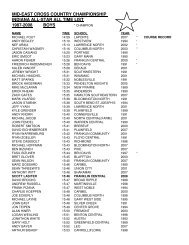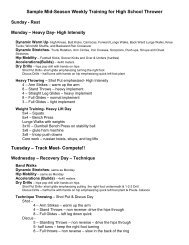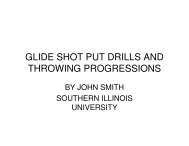Judge-Plyometric Training for Track and Field-200.pdf - iatccc
Judge-Plyometric Training for Track and Field-200.pdf - iatccc
Judge-Plyometric Training for Track and Field-200.pdf - iatccc
You also want an ePaper? Increase the reach of your titles
YUMPU automatically turns print PDFs into web optimized ePapers that Google loves.
<strong>Plyometric</strong> <strong>Training</strong><br />
A simple rule of thumb to determine if an athlete is ready <strong>for</strong> plyometrics: the athlete must be able<br />
to squat approximately 1.5x body weight.<br />
It has been suggested that athletes over 100kg should not per<strong>for</strong>m depth jumps higher than 18<br />
inches.<br />
In addition, plyometrics should not be used by athletes with orthopedic injuries.<br />
Body Weight Squat<br />
Guidelines<br />
Although authorities have placed many qualifications upon the use of plyometric training ultimately,<br />
the wisdom of the coach <strong>and</strong> close training state observation are pre-requisites to the use of this type of<br />
training.<br />
Throwers should not do very much single leg jumping, excepting javelinists.<br />
Written guidelines can never replace visual control by the coach.<br />
The Basic Jumping Skills<br />
Hop: one foot to the same foot<br />
Step: one foot to the other foot with ground contact<br />
Bound: one foot to the other with flight phase<br />
Jump: one foot to both feet or both feet to both feet<br />
Basic Jumping Skills<br />
Different Categories of <strong>Plyometric</strong>s<br />
Low Intensity<br />
Ground Level Plyo’s<br />
Medium Intensity<br />
Concentric Jumps<br />
High Intensity<br />
Depth Jumps<br />
Hurdle Hops<br />
<strong>Plyometric</strong> Exercises can be Grouped According to the Strength Qualities<br />
Elastic strength (low hurdle jumps; low drop jumps)<br />
Concentric strength (st<strong>and</strong>ing long jump; high hurdle jumps)<br />
Eccentric strength (higher drop jumps, depth jumps)<br />
<strong>Plyometric</strong> exercises should be sequenced to reflect the period in the annual plan<br />
Progression of Activities<br />
Soft surfaces to hard surfaces<br />
Harder surfaces encourage high rates of energy return<br />
The Exercise Progression is as Follows:<br />
Double leg to single leg jumps<br />
In place to moving jumps<br />
Un-weighted to weighted jumps<br />
Jumps with a pause to jumps to continuous jumps
















